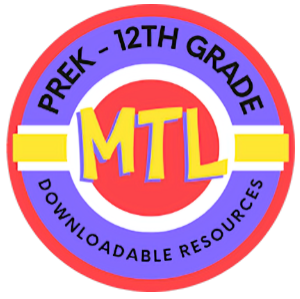Category: Zoology
Showing 21–40 of 144 resultsSorted by latest
-
 $2.00Buy Now
$2.00Buy NowWant to study the life cycle of a spider? Here is a resource for you!
Includes:
– 2 labeled posters (color and b/w)
– life cycle coloring page
– colorful center activity
– 2 cut-n-paste worksheetsUse as a standalone resource or combine with:
-
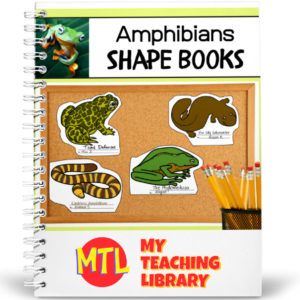 $3.00Buy Now
$3.00Buy NowHere are four different amphibian shape books for student self-publishing! There are two for frogs/toads, one for salamanders and one for caecilians.
Students can use these shape book patterns to write stories, poems, and reports. Each book pattern has a cover page, a blank page and two pages with lines. Students can use as many pages as they need to complete their work and then fasten together with staples, ribbon or string.
-
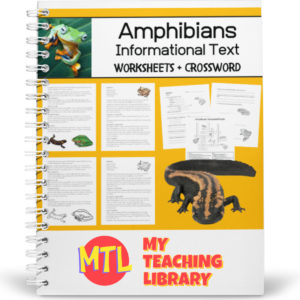 $2.00Buy Now
$2.00Buy NowThis resource has been designed to teach students about amphibians. They will learn the classification, the three types of amphibians, where they live (habitat), what the eat (diet), how they protect themselves (defense) and more.
Includes:
– Informational Text (b/w and color)
– 2 page worksheet
– Crossword puzzle
– Answer Keys
– BONUS: Large list of amphibian species -
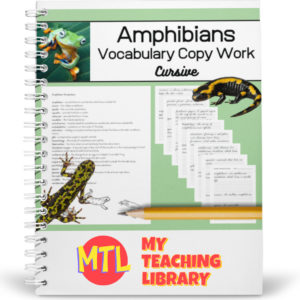 $2.00Buy Now
$2.00Buy NowStudying amphibians? Help students learn important amphibian related vocabulary words and definitions while practicing copy work and handwriting (cursive). This resource include 22 vocabulary words and definitions. (See below description for included words)
-
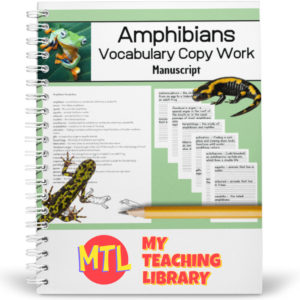 $2.00Buy Now
$2.00Buy NowStudying amphibians? Help students learn important amphibian related vocabulary words and definitions while practicing copy work and handwriting (printing – manuscript). This resource include 22 vocabulary words and definitions. (See below description for included words)
-
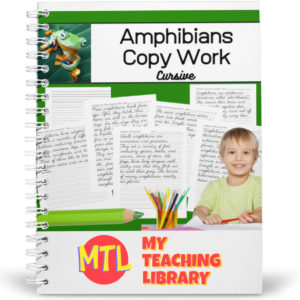 $2.50Buy Now
$2.50Buy NowTeach students about amphibians as they read and copy each page of this resource! While practicing handwriting skills copying the cursive text, students will learn about the following:
- – The meaning of the word ‘amphibian’
- – Habitat
- – Diet
- – Amphibian metamorphosis
- – Regulation of body temperature
- – Defense mechanisms
Each category above is a separate section for a total of 6 copy work lessons! Use alone as science and/or handwriting mini-lessons or as a supplement to a larger unit or curriculum.
-
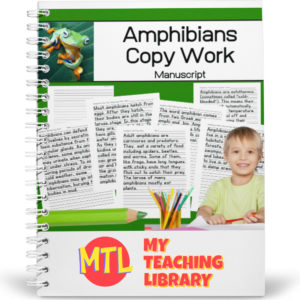 $2.50Buy Now
$2.50Buy NowTeach students about amphibians as they read and copy each page of this resource! While practicing handwriting skills copying the manuscript text, students will learn about the following:
- – The meaning of the word ‘amphibian’
- – Habitat
- – Diet
- – Amphibian metamorphasis
- – Regulation of body temperature
- – Defense mechanisms
Each category above is a separate section for a total of 6 copy work lessons! Use alone as science and/or handwriting mini-lessons or as a supplement to a larger unit or curriculum.
-
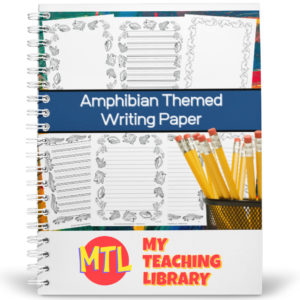 $2.00Buy Now
$2.00Buy NowThis fun amphibian themed paper can be used by all ages for a variety of uses such as writing essays, poetry, creating reports, science and nature journaling and even art projects!
Includes 9 pages:
– 3 Salamander (single lined, dashed line, blank center)
– 3 Newt (single lined, dashed line, blank center)
– 3 Frog & Toad ( (single lined, dashed line, blank center) -
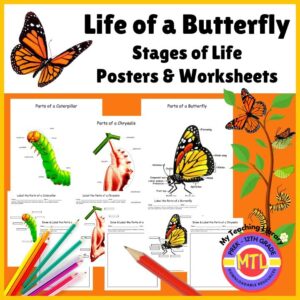 $3.50Buy Now
$3.50Buy NowThis Science / Biology resource provides colorful posters and worksheets for 3 stages of a butterfly’s life cycle: caterpillar, chrysalis, adult butterfly.
Each stage of life comes with a poster (labels showing the parts) and the following 3 worksheets:
#1: Students will label a picture of the specific stage and are given the names of the parts they are to label
#2: Students will label a picture of the specific stage but are not given the names of the parts (as they should have those memorized)
#3: Students are to both draw and label the specific stage. Parts they are to label of given.What parts are labeled for each stage?
- caterpillar: head, thorax, simple eye, mandible, walking leg, abdominal segment, proleg, anal proleg
- chrysalis: cremaster, abdomen, spiracle, wing, metathorax, mesothorax, antenna, prothorax
- adult butterfly: back leg, middle leg, front leg, spiracles, forewing, antenna, hind wing, veins, compound eye, ocellus, anus, proboscis, labial palpus
BONUS: All pages are also included in B/W format!
-
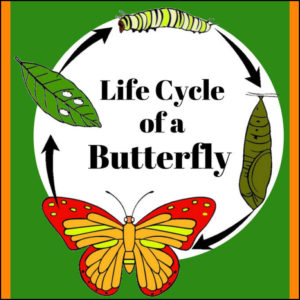 $1.75Buy Now
$1.75Buy NowThis Science resource will teach students the Life Cycle of a Butterfly and includes:
- * 2 color posters of the life cycle (1 with added details)
- * 1 b/w poster (for students to color),
- * 4 picture/information cards for each stage of the life cycle
- * 3 life cycle worksheets
-
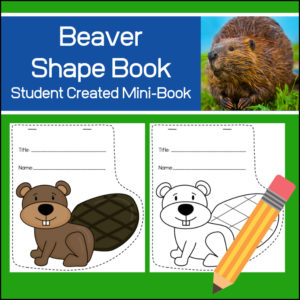 $2.00Buy Now
$2.00Buy NowStudying Beavers? Students will love to self-publish their own work in this cute Beaver shape book! Not only can they write creative stories or poems, but you can also have them use these templates to convey what they’ve learned (comprehension) from a book or from their own research! Template size: 7.5″ tall x 7″ wide.
Includes:
- 6 possible covers
- 13 different inside pages
I’ve created pages with both dotted-dashed lines as well as single lines so that you can use what best fits the level of your students.
-
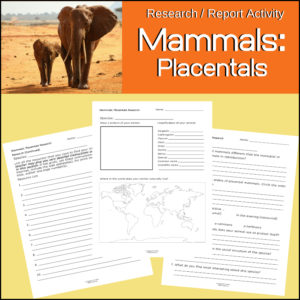 $2.00Buy Now
$2.00Buy NowPlacental mammals are the most diverse group of mammals with about 4000 discovered species and include dogs, cats, rodents, elephants, whales, cattle, pigs, humans and many more! If you are planning a study on these mammals, this product will guide students through their research and can be used as the end reporting tool!
-
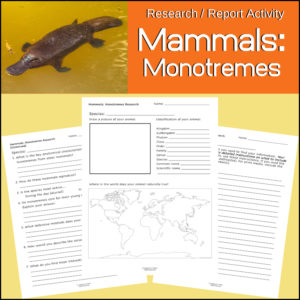 $2.00Buy Now
$2.00Buy NowThis science, animal study activity is designed to guide your students through the researching and reporting of any egg laying mammal (also known as Monotremes). These unusual mammals only reside in Australia and New Guinea. There are only five known species of monotremes: the platypus and four species of echidna.
This product will guide students through their research and can be used as the end reporting tool!
-
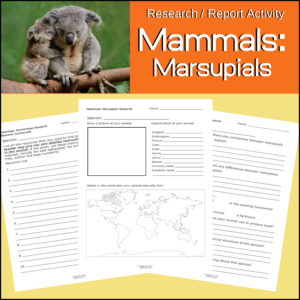 $2.00Buy Now
$2.00Buy NowStudents love kangaroos, wallabies, koalas and other pouch carrying animals also known as marsupials! This resource will guide students through their research on these amazing pouch carrying animals and can be used as the end reporting tool!
-
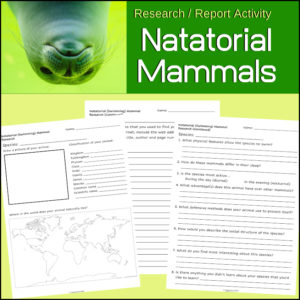 $2.00Buy Now
$2.00Buy NowAny mammal designed to swim such as a whale, sea lion, seal or walrus is considered a natatorial mammal. The term natatorial comes from the Latin natātor, natātōrem meaning “swimmer”. This product is perfect for your students if you want to assign a research & report project on water dwelling mammals. It will guide students through their research and can be used as the end reporting tool!
-
 $2.00Buy NowOne way of categorizing animals is how they move. Mammals that are designed to jump, hop, gallop, or leap are called Saltatorial mammals such as the kangaroo, leopard, rabbit, horse, antelope and many others! This product is perfect to use as a research and report assignment to have students study mammals that jump, hop, gallop and/or leap! It will guide students through their research and can be used as the end reporting tool!
$2.00Buy NowOne way of categorizing animals is how they move. Mammals that are designed to jump, hop, gallop, or leap are called Saltatorial mammals such as the kangaroo, leopard, rabbit, horse, antelope and many others! This product is perfect to use as a research and report assignment to have students study mammals that jump, hop, gallop and/or leap! It will guide students through their research and can be used as the end reporting tool! -
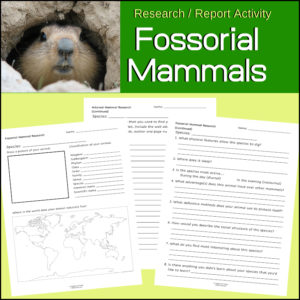 $2.00Buy Now
$2.00Buy NowBurrowing, ground dwelling mammals are known as fossorial mammals. Fossorial comes from the Latin fossor, meaning “digger”, thus mammals such as groundhogs, gophers, moles, rabbits and others are in this group. This resource will help students research and report on fossorial mammals as it guides students through their research and can be used as the end reporting tool!
-
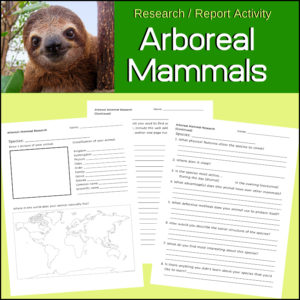 $2.00Buy Now
$2.00Buy NowDuring a study of animals (specifically tree-dwelling, arboreal mammals), students can use this product to research and report on animals such as the koala, monkey, sloth or possum. Any tree dwelling mammal is considered arboreal. Students can use this product as both a guide to their research as well as the end reporting tool!
-
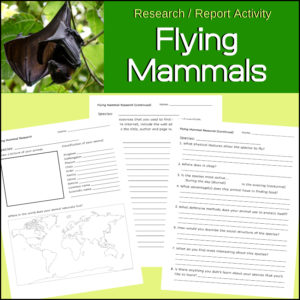 $2.00Buy Now
$2.00Buy NowIn the Science field of Zoology there is a group of mammals that are considered ‘flying’ mammals. This product makes it easy to assign students to research and report on one of these ‘flying’ mammals! Students will be able to use the product to both guide their research and use as their reporting tool.
-
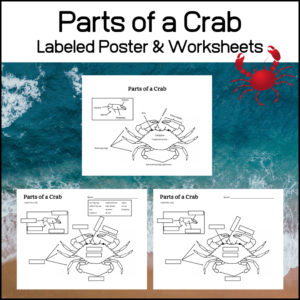 $1.25Buy Now
$1.25Buy NowIs your Science class studying (or preparing to study) ocean life, crustaceans or the phylum Arthropoda? This resource, Parts of a Crab – Poster & Worksheets, includes a labeled poster of a crab and 2 worksheets (or quizzes).
